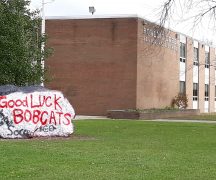By JAN McLAUGHLIN
BG Independent News
When all the provisional ballots were added in, the vote margin narrowed but failed to reverse the loss of the Bowling Green City School District levy on the November ballot.
In the end, the levy lost by 108 votes (7,174 to 7,282) – a little closer than the unofficial 150 vote difference on election night. The official counts were certified this morning by the Wood County Board of Elections.
Wood County Board of Elections Director Terry Burton said the margin was not enough to trigger an automatic recount.

This news sends Bowling Green Board of Education into planning mode. Planning for a second levy attempt next spring. And planning cuts so district residents know that personnel and programs will be on the chopping block.
The spring levy will be the last chance to prevent cuts.
After the vote counts were certified this morning, Superintendent Ted Haselman said the board members will discuss if they will repeat the income tax request, or switch to property tax.
“Anything’s on the table,” Haselman said. “But I know we’ll be back on the ballot in May.”
“I’ve said all along this is a need and not a want. We cannot continue to operate under current standards with the current revenues we have,” he said.
The five-year budget forecast presented Tuesday evening by district Treasurer Matt Feasel showed evidence of the need. If the district doesn’t pass a new operating levy, the district will be in the red by 2027.
Haselman predicted “fairly extensive” cuts will have to be made if the levy goes down again. Those cuts will be clearly outlined for voters prior to the spring election. The cuts will inevitably include staff.
“We’re in the education business. So 80% of our budget is people,” he said, adding that voters will be given specifics on what personnel and programs might be cut.
“So our community can make a decision of how they want their schools to look,” he said.
Haselman assured that school staff will continue to work hard to serve students.
“That will not change. That’s a promise,” he said. “We’ll continue to do what’s right for our kids.”
Bowling Green City School District had asked voters to support a 0.75% continuing income tax for daily operations. It was the first new operating levy for the district since 2010.
Voters were cautioned that when communities don’t pay to operate their schools, teachers lose their jobs and students pay the price, with consequences such as teacher layoffs, fewer course offerings, cuts to after-school activities, and bigger class sizes.
“We have to balance our budget – by increasing our revenue through a levy or making major cuts to programs and personnel,” Haselman said.
Since the last new operating levy was passed in 2010, school revenue has gone up an average of 1.75% annually. Over the same period, school expenditures have gone up 2.42% annually. And inflation has outpaced them both, pushing up 3.18% annually.
A chart comparing local tax collections for 15 area school districts shows Bowling Green is ranked fourth from the bottom, and has one of the lowest income taxes in the area at 0.5% currently.
Prior to the election, school officials heard questions of why the district needs more money after it just passed a bond issue last fall to build a new high school. Haselman pointed out that bond money can’t be used for daily operations, which include expenses like personnel costs, classroom supplies, facilities maintenance, textbooks, technology, transportation and utilities.
“This is how school funding works in Ohio,” he said.
“We are underfunded by the government, and sometimes at the ballot box,” board President Tracy Hovest said Tuesday evening.
The lack of support from a “significant portion of our community is disheartening” to staff and students, Hovest said.
“We have to have some tough conversations,” Hovest said.





